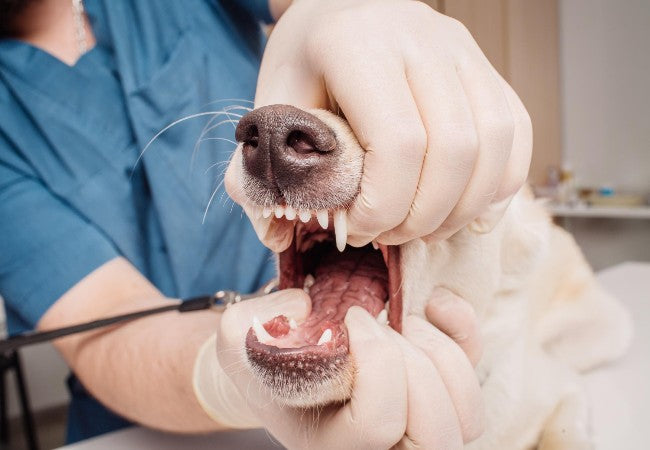Veterinary Guide to Canine Laryngeal Disease (Paralysis) 2025 🐶🩺

In this article
Veterinary Guide to Canine Laryngeal Disease (Paralysis) 2025 🐶🩺
By Dr. Duncan Houston BVSc
🧬 What Is Laryngeal Disease?
Laryngeal disease refers to any condition affecting the larynx (“voice box”), including laryngitis, edema, tumors, collapse of laryngeal saccules (common in brachycephalic breeds), and most notably, laryngeal paralysis. Respiratory obstruction in these cases can escalate to a life-threatening emergency.
⚠️ Focusing on Laryngeal Paralysis
Laryngeal paralysis is the most prevalent laryngeal issue in dogs and involves failure of the arytenoid cartilages to open properly during inhalation.
Types
- Idiopathic/Acquired – linked to Geriatric Onset Laryngeal Paralysis Polyneuropathy (GOLPP), a progressive nerve degeneration disorder.
- Congenital – present from birth, seen in breeds like Bouvier des Flandres, Siberian Huskies, Dalmatians, Bulldogs.
Who Is Affected?
- Typically older, large-breed dogs (Labs, Goldens, St. Bernards, Irish Setters, Newfoundlands).
- Less commonly, younger congenital cases in specific breeds noted above.
👀 Clinical Signs
Laryngeal paralysis often progresses slowly, manifesting initially as mild symptoms:
- Noisy or raspy breathing (inspiratory stridor).
- Excessive panting, especially in hot/humid environments.
- Exercise intolerance, lethargy, voice changes (dysphonia).
- Coughing/gagging when eating or drinking, signs of aspiration.
- Severe cases may lead to cyanosis, collapse, heat stroke.
🔍 Diagnosis
- History & physical: integrating respiratory signs and neurologic assessment.
- Laryngoscopy under light sedation – the gold standard to assess arytenoid movement.
- Imaging: Neck/thoracic X-rays to rule out masses or aspiration pneumonia.
- Neurologic screening: to detect GOLPP-related signs like limb weakness, megaesophagus.
- Genetic testing for congenital predisposition in select breeds.
🛠️ Treatment Approaches
Conservative Management (Mild Cases)
- Maintain cool, calm environments; avoid heat/exertion.
- Use harnesses, not collars, to reduce neck pressure.
- Weight management and anti-anxiety support.
- Manage aspiration pneumonia promptly with antibiotics.
Surgical Intervention: Tie‑Back (Arytenoid Lateralization)
- One-sided suture is placed to open the airway permanently.
- Improves airflow, exercise tolerance, ventilation—but increases aspiration risk.
- Recovery includes activity restriction, feeding modifications, and monitoring for aspiration.
- Long-term follow-up is essential—10–30% may experience aspiration pneumonia post-op.
Advanced/Special Considerations
- Emergency airway management: oxygen, sedatives, cooling, IV fluids; possible temporary tracheotomy.
- Brachycephalic breeds may require concurrent soft palate or saccule correction surgery.
- In congenital bilateral paralysis, laryngeal tie-back and careful anesthesia planning are vital.
📈 Recovery & Long‑Term Care
- Restricted activity and supervised feeding post‑op.
- Small, frequent meals; feed upright to avoid aspiration.
- Monitor for coughing/gagging, weight loss, exercise, or heat intolerance.
- Regular recheck exams, possibly annual laryngoscopy, and chest X-rays.
- Anticipate and monitor for GOLPP progression (neurologic decline, megaesophagus).
📱 Ask A Vet Telehealth Support
- 📸 Real-time upload of respiratory clips or cough recording for specialist review.
- 🔔 Alerts for weather, exercise, or heat risks based on your dog’s breathing patterns.
- 🩺 Virtual assessment of respiratory effort, gums, and temperature expansion.
- 💊 Guidance on harness fitting, feeding techniques, and emergency planning.
🎓 Case Spotlight: “Zeus” the Labrador
Zeus, a 9‑year‑old Lab, showed gradually worsening noisy breathing and slowed exercise pace. Laryngoscopy confirmed bilateral paralysis. He underwent left-sided arytenoid lateralization and, post-operatively, adopted harness use, cooled environment, and feeding modifications. Ask A Vet helped monitor his oxygenation during warm days and his feeding position. At two years post-surgery, Zeus remains active without aspiration complications. 🐕⚕️
🔚 Key Takeaways
- Laryngeal paralysis is the most common laryngeal issue in dogs, especially older large breeds.
- Signs include noisy breathing, exercise intolerance, voice change, and possible collapse.
- Diagnosis relies on laryngoscopy and imaging to evaluate both function and structure.
- Conservative management benefits mild cases; tie‑back surgery improves quality of life for more severe cases.
- Post‑op care includes feeding and aspiration prevention; complications like pneumonia occur in up to 30%.
- Ask A Vet telehealth enhances monitoring, environmental adjustments, feeding guidance, and hot‑weather safety 📲🐾
Dr Duncan Houston BVSc, founder of Ask A Vet. Download the Ask A Vet app to support your dog’s respiratory health—from early recognition of breathing changes to surgical planning, emergency readiness, post‑op feeding strategies, and long‑term telehealth monitoring 🐶📲






